

Sitting on the Classroom Matt: Exploring Organic Chemistry with SOLO. At the #edchatNZ Conference, I was part of an "unconference" session where we talked about giving the students the power to direct and plan their own learning.

I shared a (failed) experiment at doing this last year with some of my classes. I have blogged about the initial idea and some positive reflections. However, assessment results did not mirror the levels of engagement I observed in class, which did make me despondent about the idea. I was challenged about the reasons for its "failure" (in terms of student results), and asked if I would try it again. I was offered some great ideas for using SOLO hexagons to help make the links between concepts more transparent to the students. This blogpost will be a "living document" until the end of our Organic Chemistry unit in my Year 12 Chemistry class. DESCRIBE the Compounds I prepared some SOLO Taxonomy hexagons containing the names of the seven types of compounds we have studied (or need to study this week). EXPLORE the Compounds. #SOLO 7th Heaven. I’ve always really enjoyed using graphic organisers in the classroom or as a personal planning tool.

Now I often use them when delivering professional development to staff. They help people organise their thoughts and make their thinking very visible with just a glance over their shoulder. The very best of them scaffold students learning from the necessary shallow factual learning towards deeper conceptual learning. This is also one of the great benefits of using the SOLO Taxonomy. It helps teachers structure the learning within lessons, projects and schemes of work in a sequential and increasingly complex manner. Overview of SOLO Taxonomy and HOT Maps.Reproduced with the kind permission of Pam Hook At St. Pam Hook (@arti_choke) has spent years developing resources, presenting and leading workshops on the use of SOLO Taxonomy. 7ePlan. It’s all objective. I’m trying to simplify my thought process when planning.
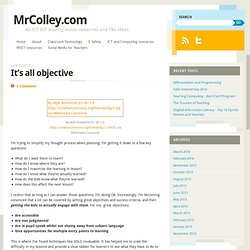
Mathematics - annotated exemplars level 1 AS91034 (Resource A. SOLO Autonomy for Beginners. I have it on good authority that autonomy is a problem when our sixth formers leave us for university life.
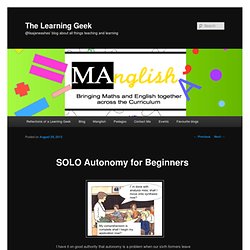
Helping pupils recognise their learning, and find ways to enhance their own exploration of the world in which they live, encourages autonomy; this must be developed earlier if we want to avoid spoon-feeding GCSE students and sixth formers forever, damaging their chances when their apron strings are finally cut. It is no good sticking a plaster on this problem at a later date; we need to get it right from the start. Feel the burn: Give yourself a SOLO cognitive workout. Nicola Richards (a fabulous PE educator in Christchurch) and I recently co-authored the latest SOLO resource – this one supports teachers charged with helping students think more deeply in movement contexts in physical education.
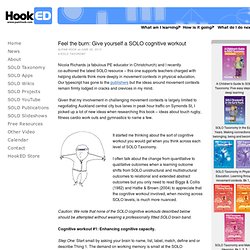
Our typescript has gone to the publishers but the ideas around movement contexts remain firmly lodged in cracks and crevices in my mind. A Geography Lesson: Making the learning visible. I remember being new to teaching and asking students to do complex thinking (analyse this….
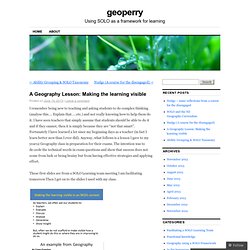
Explain that…..etc.) and not really knowing how to help them do it. I have seen teachers that simply assume that students should be able to do it and if they cannot, then it is simply because they are “not that smart”. Fortunately I have learned a lot since my beginning days as a teacher (in fact I learn better now than I ever did). Anyway, what follows is a lesson I gave to my year12 Geography class in preparation for their exams. The intention was to de-code the technical words in exam questions and show that success does not come from luck or being brainy but from having effective strategies and applying effort.
Shaun Allison Using SOLO examples. The 15 minute forum was led by Simona Trignano (newly appointed Deputy Leader in Science, KS3 – @simonatrignano).

During the session Simona went through the work that she has been doing this year as a part of her ‘Learning Innovator’ project – on SOLO taxonomy. What is SOLO Taxonomy? SOLO (Structure of Observed Learning Outcomes) provides a structured framework for students to use to progress their thinking and learning. It encourages students to think about where they are currently with there learning, and what they need to do in order to progress. There are five main stages: Head St Mary's redesigning classrooms. Presentations. What is SOLO + useful blog links. The concept was first developed in 1982 (Biggs and Collis) and has since been defined as: ‘Structure of the Observed Learning Outcome, a means of classifying learning outcomes in terms of their complexity, enabling us to assess students’ work in terms of its quality not of how many bits of this and of that they got right.’
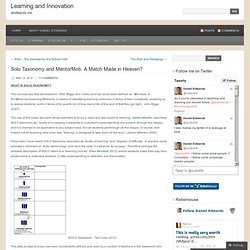
John Biggs (2007) Tait Coles usinf SOLO and Real smart. Following on from the success of SOLO Stations (see blog post here) I wanted to tweak it even further and so decided to link the idea with RealSmart.
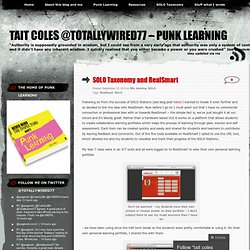
Now before I go on I must point out that I have no commercial connection or professional bias with or towards RealSmart – the simple fact is, we’ve just bought it at our school and it’s bloody great. Rather than a hardware based VLE it works on a platform that allows students to create collaborative learning portfolios which helps the process of learning through peer, mentor and self assessment. Pam Hook 5 ways to use SOLO CPD.